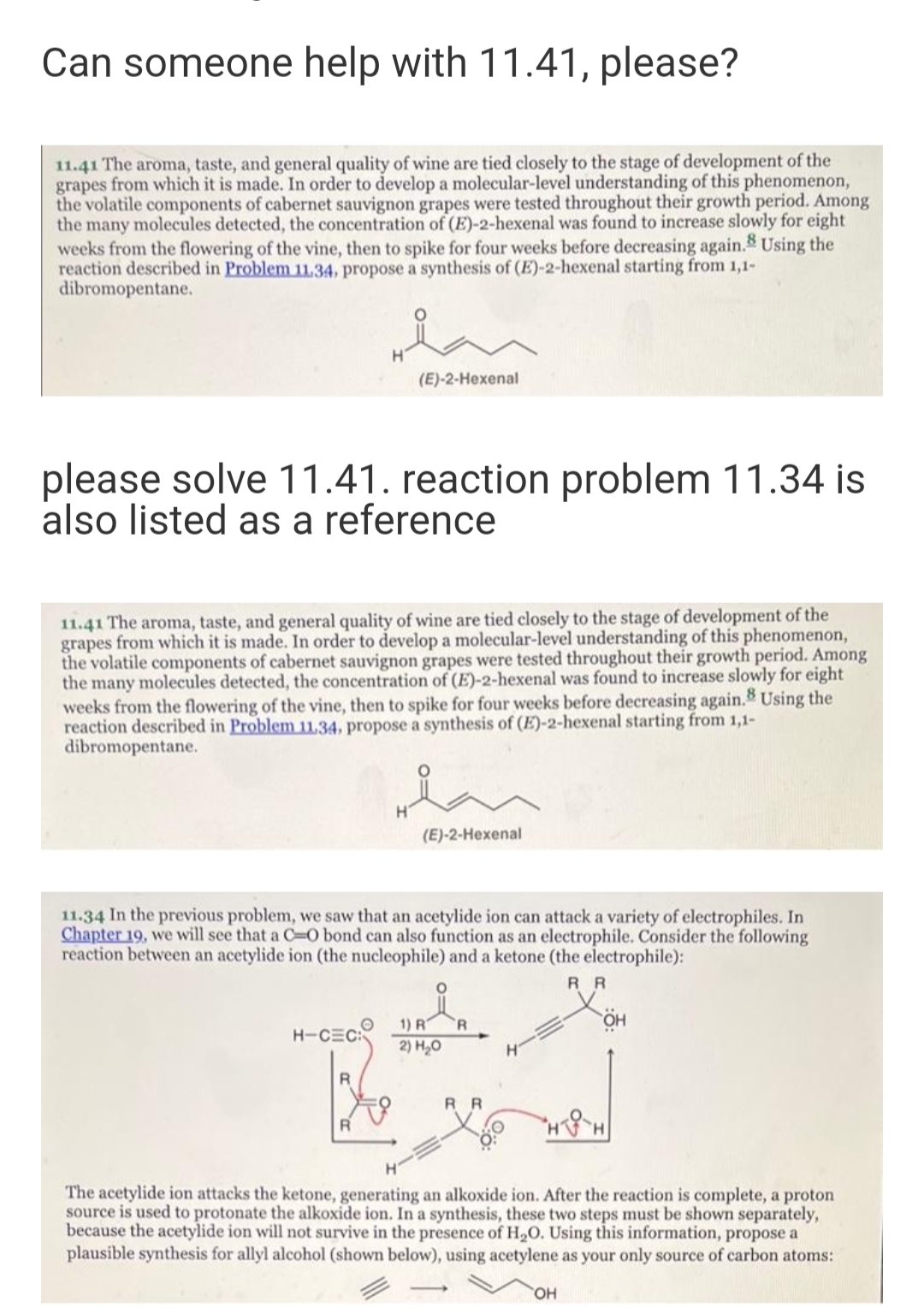11.41 The aroma, taste, and general quality of wine are tied closely to the stage of development of the grapes from which it is made. In order to develop a molecular-level understanding of this phenomenon, the volatile components of cabernet sauvignon grapes were tested throughout their growth period. Among the many molecules detected, the concentration of (E)-2-hexenal was found to increase slowly for eight weeks from the flowering of the vine, then to spike for four weeks before decreasing again. Using the reaction described in Problem 11.34, propose a synthesis of (E)-2-hexenal starting from 1,1- dibromopentane. (E)-2-Hexenal
11.41 The aroma, taste, and general quality of wine are tied closely to the stage of development of the grapes from which it is made. In order to develop a molecular-level understanding of this phenomenon, the volatile components of cabernet sauvignon grapes were tested throughout their growth period. Among the many molecules detected, the concentration of (E)-2-hexenal was found to increase slowly for eight weeks from the flowering of the vine, then to spike for four weeks before decreasing again. Using the reaction described in Problem 11.34, propose a synthesis of (E)-2-hexenal starting from 1,1- dibromopentane. (E)-2-Hexenal
Introduction to General, Organic and Biochemistry
11th Edition
ISBN:9781285869759
Author:Frederick A. Bettelheim, William H. Brown, Mary K. Campbell, Shawn O. Farrell, Omar Torres
Publisher:Frederick A. Bettelheim, William H. Brown, Mary K. Campbell, Shawn O. Farrell, Omar Torres
Chapter6: Solutions And Colloids
Section: Chapter Questions
Problem 6.55P: 6-55 According to the label on a piece of cheese, one serving of 28 g provides the following daily...
Related questions
Question

Transcribed Image Text:Can someone help with 11.41, please?
11.41 The aroma, taste, and general quality of wine are tied closely to the stage of development of the
grapes from which it is made. In order to develop a molecular-level understanding of this phenomenon,
the volatile components of cabernet sauvignon grapes were tested throughout their growth period. Among
the many molecules detected, the concentration of (E)-2-hexenal was found to increase slowly for eight
weeks from the flowering of the vine, then to spike for four weeks before decreasing again. Using the
reaction described in Problem 11.34, propose a synthesis of (E)-2-hexenal starting from 1,1-
dibromopentane.
(E)-2-Hexenal
please solve 11.41. reaction problem 11.34 is
also listed as a reference
11.41 The aroma, taste, and general quality of wine are tied closely to the stage of development of the
grapes from which it is made. In order to develop a molecular-level understanding of this phenomenon,
the volatile components of cabernet sauvignon grapes were tested throughout their growth period. Among
the many molecules detected, the concentration of (E)-2-hexenal was found to increase slowly for eight
weeks from the flowering of the vine, then to spike for four weeks before decreasing again. Using the
reaction described in Problem 11.34, propose a synthesis of (E)-2-hexenal starting from 1,1-
dibromopentane.
(E)-2-Hexenal
11.34 In the previous problem, we saw that an acetylide ion can attack a variety of electrophiles. In
Chapter 19, we will see that a C-O bond can also function as an electrophile. Consider the following
reaction between an acetylide ion (the nucleophile) and a ketone (the electrophile):
R R
1) R
R
H-CEC
2) H,0
H.
R R
The acetylide ion attacks the ketone, generating an alkoxide ion. After the reaction is complete, a proton
source is used to protonate the alkoxide ion. In a synthesis, these two steps must be shown separately,
because the acetylide ion will not survive in the presence of H20. Using this information, propose a
plausible synthesis for allyl alcohol (shown below), using acetylene as your only source of carbon atoms:
HO,
Expert Solution
This question has been solved!
Explore an expertly crafted, step-by-step solution for a thorough understanding of key concepts.
This is a popular solution!
Trending now
This is a popular solution!
Step by step
Solved in 2 steps with 1 images

Knowledge Booster
Learn more about
Need a deep-dive on the concept behind this application? Look no further. Learn more about this topic, chemistry and related others by exploring similar questions and additional content below.Recommended textbooks for you

Introduction to General, Organic and Biochemistry
Chemistry
ISBN:
9781285869759
Author:
Frederick A. Bettelheim, William H. Brown, Mary K. Campbell, Shawn O. Farrell, Omar Torres
Publisher:
Cengage Learning

Physical Chemistry
Chemistry
ISBN:
9781133958437
Author:
Ball, David W. (david Warren), BAER, Tomas
Publisher:
Wadsworth Cengage Learning,

EBK A SMALL SCALE APPROACH TO ORGANIC L
Chemistry
ISBN:
9781305446021
Author:
Lampman
Publisher:
CENGAGE LEARNING - CONSIGNMENT

Introduction to General, Organic and Biochemistry
Chemistry
ISBN:
9781285869759
Author:
Frederick A. Bettelheim, William H. Brown, Mary K. Campbell, Shawn O. Farrell, Omar Torres
Publisher:
Cengage Learning

Physical Chemistry
Chemistry
ISBN:
9781133958437
Author:
Ball, David W. (david Warren), BAER, Tomas
Publisher:
Wadsworth Cengage Learning,

EBK A SMALL SCALE APPROACH TO ORGANIC L
Chemistry
ISBN:
9781305446021
Author:
Lampman
Publisher:
CENGAGE LEARNING - CONSIGNMENT